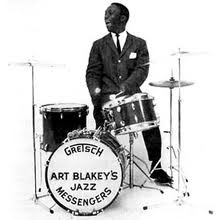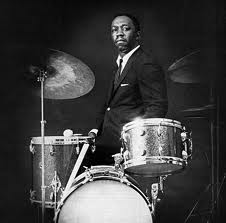 'Art Blakey was a famous American drummer and bandleader who
revolutionized the way jazz drums were played. His unique approach to
drumming incorporated bits of swing, blues, funk and hard bop; a style
which is heard today in drummers everywhere. Along with Max Roach and
Kenny Clarke, he is considered to have invented the modern bebop style
of drumming. For over 30 years, his band The Jazz Messengers launched
the careers of a multitude of famous jazz artists, like Benny Golson,
Wayne Shorter, Clifford Brown, Curtis Fuller, Horace Silver, Freddie
Hubbard, Keith Jarrett, Wynton Marsalis and countless others. The Jazz
Messengers not only produced phenomenal music, but served as a proving
ground of sorts for young musicians, similar to Miles Davis’ band. Art
Blakey’s style changed the way jazz sounded, and the way drums were
played in modern bebop'. Ladies and Gentlemen, Art Blakey.
'Art Blakey was a famous American drummer and bandleader who
revolutionized the way jazz drums were played. His unique approach to
drumming incorporated bits of swing, blues, funk and hard bop; a style
which is heard today in drummers everywhere. Along with Max Roach and
Kenny Clarke, he is considered to have invented the modern bebop style
of drumming. For over 30 years, his band The Jazz Messengers launched
the careers of a multitude of famous jazz artists, like Benny Golson,
Wayne Shorter, Clifford Brown, Curtis Fuller, Horace Silver, Freddie
Hubbard, Keith Jarrett, Wynton Marsalis and countless others. The Jazz
Messengers not only produced phenomenal music, but served as a proving
ground of sorts for young musicians, similar to Miles Davis’ band. Art
Blakey’s style changed the way jazz sounded, and the way drums were
played in modern bebop'. Ladies and Gentlemen, Art Blakey. Blakey was born in Pittsburgh Pennsylvania .
By the time he was a teenager, he was playing the piano full-time,
leading a commercial band. Shortly afterwards, reputedly because he
thought he would be unable to compete with the emerging pianist Erroll Garner, he taught himself to play the drums in the aggressive swing style of Chick Webb, Sid Catlett and Ray Bauduc. He joined Mary Lou Williams as a drummer for an engagement in New York in autumn 1942. He then toured with the Fletcher Henderson Orchestra (1939–1942). During his years with Billy Eckstine’s big band (1944–7), Blakey became associated with the bebop movement, along with his fellow band members Miles Davis, Dexter Gordon, Fats Navarro and others.
Blakey was born in Pittsburgh Pennsylvania .
By the time he was a teenager, he was playing the piano full-time,
leading a commercial band. Shortly afterwards, reputedly because he
thought he would be unable to compete with the emerging pianist Erroll Garner, he taught himself to play the drums in the aggressive swing style of Chick Webb, Sid Catlett and Ray Bauduc. He joined Mary Lou Williams as a drummer for an engagement in New York in autumn 1942. He then toured with the Fletcher Henderson Orchestra (1939–1942). During his years with Billy Eckstine’s big band (1944–7), Blakey became associated with the bebop movement, along with his fellow band members Miles Davis, Dexter Gordon, Fats Navarro and others.By the late forties and early fifties, Blakey was backing musicians such as Miles Davis, Bud Powell and Thelonious Monk — he is often considered to have been Monk's most empathetic drummer, and he played on both Monk's first recording session as a leader (for Blue Note Records in 1947) and his final one (in London in 1971), as well as many in between.
Blakey said that he travelled to Africa during 1948 and 1949. He converted to Islam during this period and took the name Abdullah Ibn Buhaina (which led to the nickname "Bu"). In the early 1950s he performed and broadcast with such musicians as Charlie Parker and Miles Davis.
From his earliest recording sessions with Eckstine, and particularly in his historic sessions with Monk in 1947, Blakey exuded power and originality, creating a dark cymbal sound punctuated by frequent loud snare- and bass-drum accents in triplets or cross-rhythms. Although Blakey discouraged comparison of his own music with African drumming, he adopted several African devices, including rapping on the side of the drum and using his elbow on the tom-tom to alter the pitch. His much-imitated trademark, the forceful closing of the hi-hat on every second and fourth beat, was part of his style from 1950 to '51. A loud and domineering drummer, Blakey also listened and responded to his soloists. His contribution to jazz as a discoverer and molder of young talent over three decades was no less significant than his very considerable innovations on his instrument.
 Blakey went on to record dozens of albums with a constantly changing
group of Jazz Messengers — he had a policy of encouraging young
musicians: as he remarked on-mike during the live session which resulted
in the A Night at Birdland albums in 1954: "I'm gonna stay with the youngsters. When these get too old I'll get some younger ones. Keeps the mind active."
After weathering the fusion era in the 1970s with some difficulty
(recordings from this period are less plentiful and include attempts to
incorporate instruments like electric piano), Blakey's band got
revitalized in the early 1980s with the advent of neotraditionalist
jazz. Blakey's ferociousness and tenacity while drumming earned him the
nickname "Jazz Tiger", or "The Tiger of Jazz". Wynton Marsalis
was for a time the band's trumpeter and musical director, and even
after Marsalis's departure Blakey's band continued as a proving ground
for many "Young Lions" like Johnny O'Neal, Philip Harper, Terence Blanchard, Donald Harrison and Kenny Garrett.
Blakey went on to record dozens of albums with a constantly changing
group of Jazz Messengers — he had a policy of encouraging young
musicians: as he remarked on-mike during the live session which resulted
in the A Night at Birdland albums in 1954: "I'm gonna stay with the youngsters. When these get too old I'll get some younger ones. Keeps the mind active."
After weathering the fusion era in the 1970s with some difficulty
(recordings from this period are less plentiful and include attempts to
incorporate instruments like electric piano), Blakey's band got
revitalized in the early 1980s with the advent of neotraditionalist
jazz. Blakey's ferociousness and tenacity while drumming earned him the
nickname "Jazz Tiger", or "The Tiger of Jazz". Wynton Marsalis
was for a time the band's trumpeter and musical director, and even
after Marsalis's departure Blakey's band continued as a proving ground
for many "Young Lions" like Johnny O'Neal, Philip Harper, Terence Blanchard, Donald Harrison and Kenny Garrett. Blakey continued performing and touring with the group into the late 1980s; Ron Wynn
notes that Blakey had "played with such force and fury that he
eventually lost much of his hearing, and at the end of his life, often
played strictly by instinct." Some reports suggest Blakey had hearing problems as early as 1959. Blakey died in 1990 in New York City, leaving behind a vast legacy and approach to jazz which is still the model for countless hard-bop players.
Blakey continued performing and touring with the group into the late 1980s; Ron Wynn
notes that Blakey had "played with such force and fury that he
eventually lost much of his hearing, and at the end of his life, often
played strictly by instinct." Some reports suggest Blakey had hearing problems as early as 1959. Blakey died in 1990 in New York City, leaving behind a vast legacy and approach to jazz which is still the model for countless hard-bop players.Source: Wikipedia

No comments:
Post a Comment